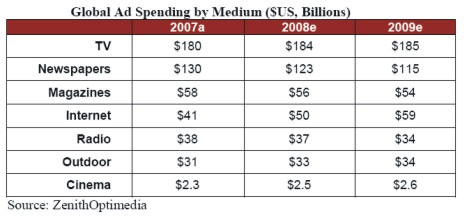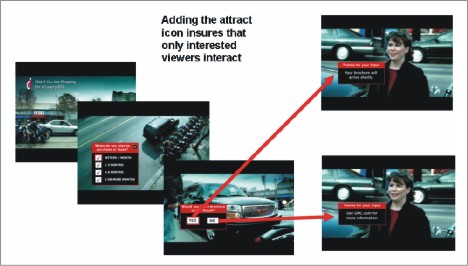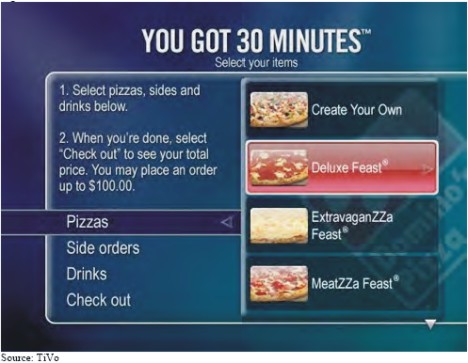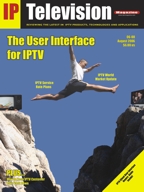|
Advanced
TV Advertising

more
details
 |
|
Traditional advertising is going through a very challenging phase. Global spending on advertising was down in 2008 and is expected to go down further in 2009. Many companies have trimmed their advertising budgets and some are switching to different advertising mediums. Macy's, for instance, has discontinued all magazine ads for the first half of 2009 . Television continues to retain its leading position and is still showing an upward trend. Figure 1 shows that global ad spending is going to increase in the coming years and the forecast for 2009 is $185
billion in spending.
Despite these numbers, there is no denying that advertisers are not aware of the inherent problems associated with television advertising. Rather than watching ads, TV viewers see ad breaks as the opportunity to switch channels or do some other activity. The advertising industry has now started looking at the advances made by digital advertising platforms with great interest.
Ads using interactive TV are typically offered as icons or hot spots and are super-imposed on regular content. Customers with interactive TV systems have the option of viewing these ads along with |
standard programming. Viewers can click on these links using enabled remote controls. Activation of a link takes the viewer to a telescoped ad, which is a longer advertisement about that product or service. Telescoped ads incorporate interactivity, giving the network operator and the advertiser a better idea of how many viewers are being impacted by the ad.
TYPES OF INTERACTIVE ADS
Overlays: These are often referred to as banners, pop-ups, or impulse responses. The overlays are placed over a spot and appear synchronously within the time span of the associated spot. They do not take the viewer to another channel. Overlays are commonly used to provide simple offers (samples, brochures, coupons, contests, etc.), give additional product information or gather viewer data. Given the time constraints of the ad and the fact that it appears on top of a program, it typically consists of simple text and graphics only. |
|

|
|
Figure 1: Global Ad Spending by Medium
|
|
|
|
 |
|
Figure 2: Telescoped Advertisements Source: OpenTV Interactive Advertising White Paper |
|
Video On Demand (VOD): Subscription-based VOD is not proving to be very successful and, as such, service providers are moving to ad supported models, in which sponsors run ads before VOD content that the consumers have chosen to watch. Ad-sponsored VOD is often referred as Free On Demand (FOD) as it is provided at no cost to subscribers.
Request For Information (RFI) Ads: RFI ads provide offers to viewers, such as samples, brochures, event invitations, or bill-me-later subscriptions. Viewers can respond to the ads using interactive applications on the set top box itself. If an STB does not support such feature, the consumer can respond via phone. Advertisers will surely make use of this form of advanced advertising extensively in 2009.
Non-RFI Overlay Ads: Since there is no viewer request for information, these ads usually provide or collect information, but make no offers to the viewer. They include messaging, surveys, or polls and these campaigns are often informative and engaging for the viewer. They sometimes act as RFIs during the conduction of surveys and polls, as they obtain responses from viewers.
Branded interactive games: These may be sponsored and allow the placement of product images, which are typically woven into the game. This creates an association and engagement with the brand, particularly if linked with tunneled ads. Some of the major brands like Warner Brothers, Aquafresh, Dominos, and Mattel have worked with PlayJam, a leading interactive games channel, to develop games that make use of their brand to reach market segments in a new and innovative way. |
TARGETING AND OTHER FACTORS
Targeting is an aspect of advertising that has thus far been used successfully in Internet advertising. Interactive television advertising campaigns can be targeted and addressed to reach a desired audience using household data collected by STB providers. Such data can be further refined according to demographic and geographic attributes or even purchase records from an advertiser's own customer list. Data can be targeted down to the individual set-top box level which is the lowest metric of measurement. The direct targeting of customers leads to higher than average response rates to generate leads or sell products and services via this medium.
CHALLENGES TO INTERACTIVE TV ADVERTISING
An advertising campaign is usually conceived for three mediums - newspapers and magazines, x-second TV spots, and mobile. For interactive TV advertising to thrive, ad agencies need to incorporate interactive TV advertising into this ecosystem. The interactivity-based campaigns are more complex to create and manage, but worthwhile due to the benefits derived.
Many consider interactive advertising to be synonymous with targeted interactive advertising. Targeting requires the collection of personal |
|

|
|
Figure 3: Domino's Pizza Ad |
|
information as well as the browsing history of the members of the household. This leads to apprehensions about privacy amongst subscribers. Many customers do not want data about the ads that they are watching or purchases they are making to be logged. To work effectively, many ad components may require logging of such historic data.
Another challenge is the small number of consumers that have access to interactivity on their televisions, making it difficult to reach large numbers of consumers. Currently, there is a lack of critical mass deployment of interactive services. Large advertisers, for example, look for coverage starting at 40% of the market, and tend to be uninterested in any percentage less than that.
Lastly, within the service provider's network there is still a lack of interoperability between different components such as head ends, networks, and set-top boxes. Therefore, it is difficult to implement other components to an ad system, such as traffic and billing systems or sales order management systems.
ADVERTISING PLATFORMS
Despite being in its infancy, the interactive television advertising industry has come up with some very stable platforms. Packet Vision's ad server enables broadcasters and network operators to increase advertising revenues through targeted addressable advertising over |
IPTV. In the US, IPTV operators are utilizing local ad insertion/replacement with support for limited geographic targeting. Geographic and demographic ad targeting are being used by European Telecom operators and TV channels.
Tandberg Television, an Ericsson company, offers AdPoint, which is a product that enables dynamic ad insertion in VOD. Tandberg also offers an interactive TV solution suite that supports voting and polling, called Xport. Black Arrow's ad-management system is most commonly used for VOD advertising.
INTERACTIVE ADVERTISEMENT EXAMPLES
Some of the successful interactive advertisement campaigns of recent times are:
1. Disney Vacations: This ad is a type of telescope. Disney purchased a regular 30-second spot from Cablevision. It also produced a longer ad about its vacation options. Consumers could then click their enabled remote to request a brochure or a sales call.
Results: The first-level response rate was about 1%, which is in the normal range for first response or click-through. The secondary response was very good and about 23% of responding customers ended up booking a vacation. |
|
2. Domino's Pizzas: This ad is a type of telescope from a previous screen to an actual order form. There is no payment functionality integrated with this ad and the payment is collected directly from the customer.
Results: The ad is still at early stages of implementation and no concrete data is available.
3. Virgin Media TV: This ad is a type of FOD which makes use of targeted user information collected in real-time, and shows ads from UK advertisers, Kellogg's, John Lewis, and Royal Mail. If a user watches the ad, pertinent information is logged in the system and more ads of that type are delivered to that user.
Results: Fifty percent of customer base watches these FODs as they are free. |
CONCLUSION
Though the years 2008-2010 look to be very difficult for the advertising world, there is hope with this new medium, interactive television. Ad agencies are starting to recognize that they need to evolve to sustain revenue. There is a definite scope for all the innovations that may lead to the generation of revenue and ad channels. Interactive television may therefore transform the television industry just as Google has done for Internet advertising.
|
|
 Swati
Sahai owns technoscribe.in, a technical communication and e-learning
company in India. She was earlier employed by Ericsson and has a
Masters in Telecommunications Technology from Aston University, UK. Swati
Sahai owns technoscribe.in, a technical communication and e-learning
company in India. She was earlier employed by Ericsson and has a
Masters in Telecommunications Technology from Aston University, UK.
For more information go to www.technoscribe.in |

more details
|
Advanced TV Advertising
This book explains the basics of audio and video digitization and compression
and the standard formats that are used be MPEG. You will learn about the
different MPEG audio coders and video coder options.
$19.99
Printed, $16.99 eBook
|
|
|
|
|






 Swati
Sahai owns technoscribe.in, a technical communication and e-learning
company in India. She was earlier employed by Ericsson and has a
Masters in Telecommunications Technology from Aston University, UK.
Swati
Sahai owns technoscribe.in, a technical communication and e-learning
company in India. She was earlier employed by Ericsson and has a
Masters in Telecommunications Technology from Aston University, UK.